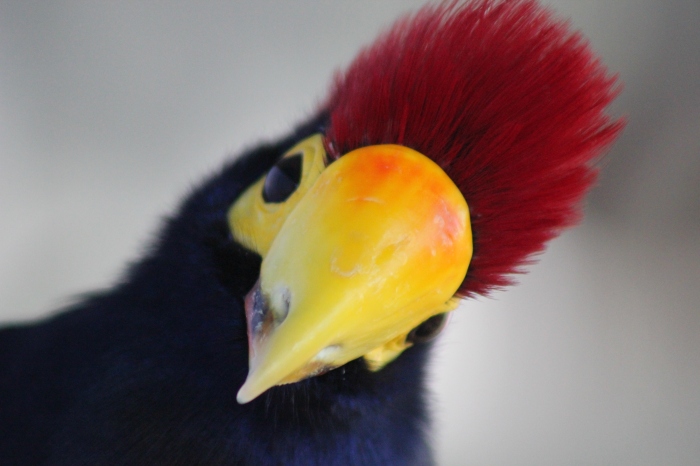
Check out the results of the Turaco Survey 2020!
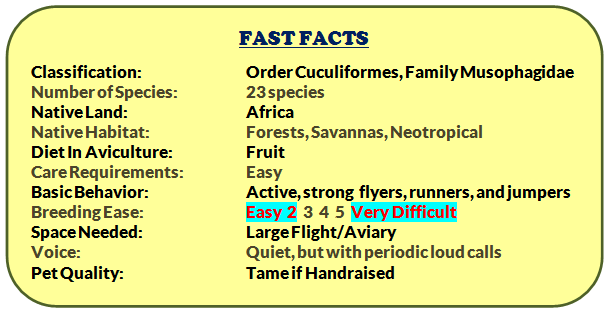 Uniquely Beautiful Birds
Uniquely Beautiful Birds
The beauty of turacos strikes you immediately. They all have raised head crests, long tails, graceful movements, and an intelligent look in their eyes. These large softbills are curious and not prone to hiding, making them very “showy” in captivity. Even most wild birds will become used to your presence quickly and allow you to approach closely, especially if you have a yummy tidbit such as a grape. Hand-raised turacos are even tamer, and, although few adult turacos allow petting, they will land on your head and shoulders, peck at your clothes, and beg for treats.
Turaco physiology is such that scientists are not in agreement as to the turaco’s nearest relative, with the cuckoos seeming to be the most popular choice at this time. How many species and subspecies is debatable as well, and the scientific names seem to change from one reference to the next, so doing research on this family is a confusing ordeal. To add to the confusion, the common names (and pronunciations) are many. Turacos are also known as touracos, tauracos, go-away birds, plantain eaters, and louries.
Turacos can be grouped by overall body color. The green group (genus Tauraco) is the largest and most commonly found group in USA aviculture, with the Persa and the Red-Crest the most popularly kept species. Next is the purple group (genus Musophaga), then the grey group (genera Corythaixoides and Crinifer) with the Western Grey species leading that group in popularity. The only member of the blue group, the Great Blue Turaco (Corythaeola cristata) is rare in the USA with few in private hands and is very difficult to breed.
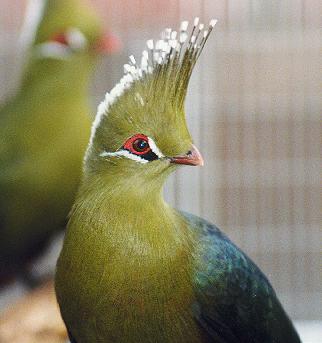
Turacos In Aviculture
Although uncommon in private general bird collections, turacos are popular softbill birds, although specific species and genders can be difficult to find. Zoos in particular like turacos as they make great display birds. Most zoos have at least one pair. The World Wildlife Zoo in Arizona even has a turaco feeding exhibit where the public may enter and feed numerous turacos much like the well known lory feeding exhibits in many zoos.
Turacos are easy to care for, generally quiet, and beautifully colored. They are hardy, long-lived (15+yrs) birds, and few health problems occur if kept properly. Their one drawback is that they are very active and need large aviaries. Unfortunately, this requirement keeps them out of reach of many bird fanciers. They cannot be kept like pet parrots, as turacos are not indoor pet birds. Aviaries need to be big enough so that the birds can run along branches, jump, and fly back and forth. A 4’x10’x8′ flight would be a suggested size for a single or pair to be happy. Outdoor planted aviaries are best. They can tolerate temperature dips into the high 30’s F without supplemental heating as long as shelter is provided against wind and rain.
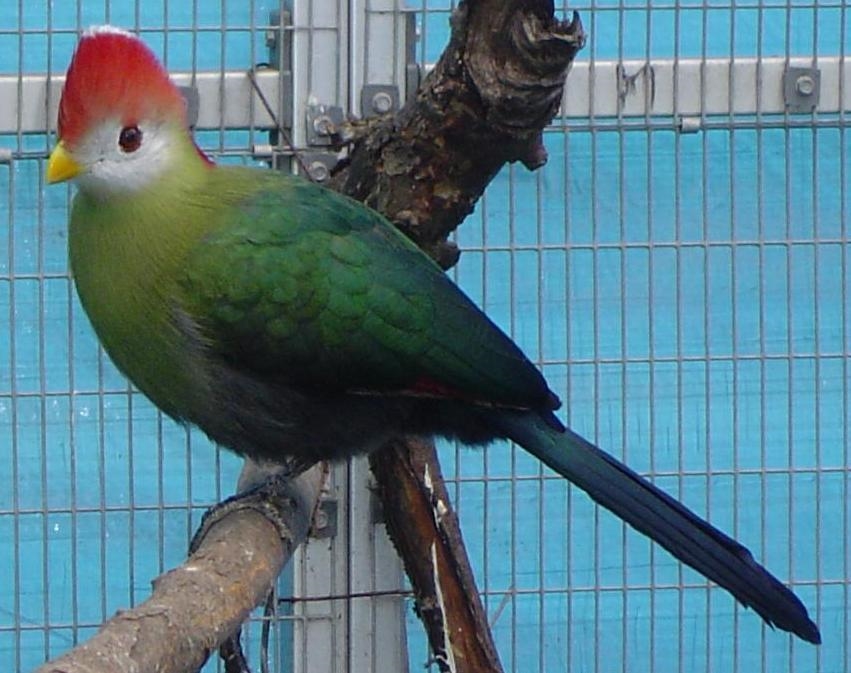
While turacos mix well with other birds, they do not mix well with other turacos unless the aviary is very large. One pair per flight is recommended as fatalities can occur quickly. Even bonded pairs can explode with vicious aggressive bouts.
Due to the federal CITES laws, few turacos species are allowed to be imported anymore, so what species we now have in this country we must work to preserve. Houston Zoo is a leader in the zoological community for turaco aviculture, and some private aviculturists are concentrating on turacos as well. However, more turaco people are needed to ensure the future of turacos in aviculture. Maybe you can be one?
We would highly recommend turacos to beginners and experienced bird fanciers alike that enjoy observe beauty and personality in their birds, but do not need to make them household pets, and have a budget and space large enough to accommodate their large housing needs. Turacos make very satisfying aviculture subjects, and we hope to see more of them in the future.
For more information on the current status of turacos in aviculture, see the results of the 2022 Turaco Survey.

Diet In Captivity
Turacos are frugivous, which means they are mainly fruit eaters. Turaco diet consists of chopped fruits (and some vegetables) daily, such as grapes, apples, bananas, melons, papaya, squash, pears, etc. At least five different types a day! The grey and blue turacos species require a more vegetarian diet and are not beginner birds. Give softbill pellets available dry all day to turacos. Pellet brands of Kaytee Exact Mynah, Zupreen Softbill, and Mazuri Softbill are recommended. Turaco food must be cut small enough to be swallowed whole, as they cannot chew although they can tear at spiked fruit too.
Breeding Turacos
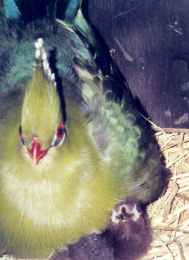
Turacos can be bred in captivity and are one of the easiest softbills to raise. The green and purple turacos species are the easiest to breed. Individuals must be sexed surgically or by DNA as males and females look alike (sexually monomorphic). They nest in trees, building a flimsy stick nest much like a dove. In captivity, birds can be given a nestbox filled with alfalfa and sticks, in which two eggs are laid. Both parents take part in incubating for the 22 days and also in caring for the young. Chicks are wide-eyed with fluffy, black feathering. They fledge quickly and wean at about five weeks old.
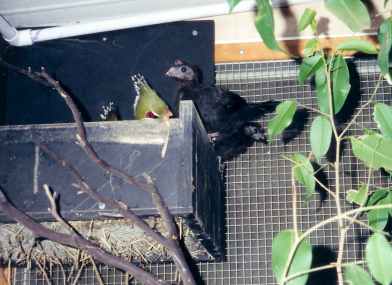
Babies can also be easily hand-raised, although we prefer to have the parents raise their own young. Hand-raised birds become very tame and totally unafraid of humans. Aggression towards humans is not uncommon in sexually mature birds as a result. Some hand-raised birds can have problems bonding to a mate as an adult, but most individuals do fine as breeders.
For more details on handraising turacos, please open the Handraising Turacos page here.
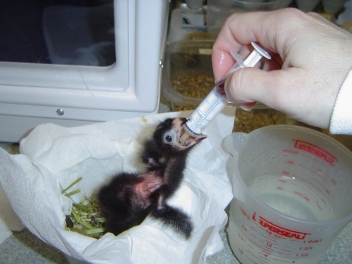
Want to learn more? Get Turacos In Aviculture! Available as a printed book $29.95 & an Ebook $15.99.

Written by Kateri Davis, an aviculturist with over twenty years of experience raising turacos, this book is filled with up-to-date information and over 175 color photographs on how to care for and breed these active and unique birds. Each species and subspecies is examined, with details about their life in the wild and aviculture. Extensive information about diet, care, parentraising and handrearing turacos is covered, including a chapter on hybridizing. The beginning bird fancier as well as the experienced aviculturist will find this book interesting, enlightening, and useful. Click here!.
Turaco Species
This site presents material for your information, education, and entertainment. All photographs were taken by the Davis Lunds. All photos and text are property of the Davis Lunds.
You may not copy, distribute, modify, reuse, or transmit any portions of this site for commercial or public use without written permission from the Davis Lunds.
No text or photos can be copied for use in other websites, personal or commercial.
Copyright 07/09 Kateri Davis



















